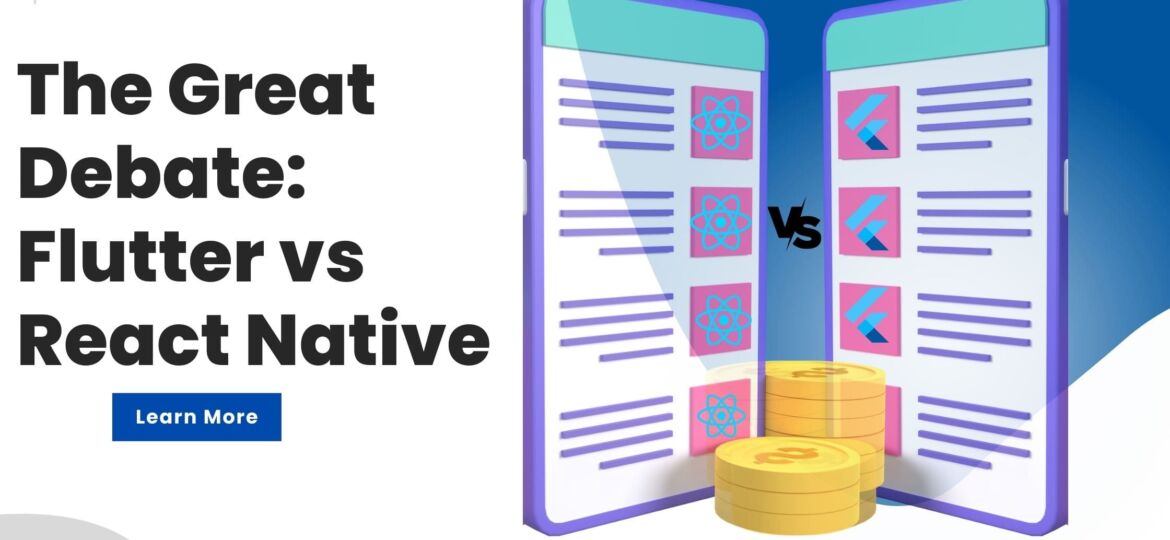
The Great Debate: Flutter vs React Native
Are you a mobile app developer looking for the best tool to use? Or maybe you’re a business owner wanting to leverage the benefits of cross-platform mobile app development. Either way, one decision you likely struggle with is whether to choose Flutter or React Native for your project.
With the rise of mobile technology and with many hybrid frameworks, businesses are increasingly turning to mobile app development as a way to reach their customers. Mobile applications enhance user experience and increase engagement with customers. But with so many Cross-Platform Development frameworks available, how do you know which one is right for your business?
In this blog post, we will explore the differences between Flutter and React Native in-depth and discuss their advantages and disadvantages so that you can make an informed decision on which cross-platform framework is right for you.
Programming Language
When it comes to choosing a programming language for Mobile development, both Flutter and React Native have their advantages. Flutter Framework is a modern, open-source UI toolkit that is powered by the Dart programming language for Cross-Platform app Development. It is capable of creating high-performance, expressive, and, interactive mobile applications with platform-specific code and a hot reloading feature.
React Native, on the other hand, is a JavaScript-based framework that is designed to create native applications. React Native offers developers the ability to create native code for cross-platform apps with a single codebase. Both Flutter and React Native are powerful tools and they offer native developers the ability to create engaging and interactive cross-platform applications.
Development Environment
The development environment is an important factor to consider when debating between the Flutter app and React Native. Flutter Framework is a comprehensive SDK that includes its development environment. This includes the Dart programming language and a set of third-party libraries, along with an integrated development environment created by Google. Flutter uses an open-source framework called Material Design, which makes it easy to build beautiful applications with the fastest development time.
Whereas, React Native’s framework is JavaScript and is compatible with existing development environments. As it operates within the JavaScript framework React JS, which allows React developers to create compelling user interfaces quickly and efficiently. Both frameworks offer hot reloading capabilities, allowing developers to see changes in real-time without having to restart their application each time they make a change.
Platform Support
When it comes to platform support, both Flutter and React Native are great choices. Flutter app development provides support for both Android & iOS, while React Native provides support for iOS, Android, Windows, and Web applications. What’s more, Flutter can be used to create desktop apps, while React Native can be used to create cross-platform applications that can run across multiple devices without needing any additional code changes or modifications.
Flutter is a native framework that supports both Android and iOS platforms out of the box with a single codebase, whereas React Native requires a bridge to support iOS devices (but does support Android). This means that apps with Flutter are often faster and more responsive than those built with React Native, especially on older devices or lower-end smartphones.
Performance
In terms of performance, both platforms offer excellent performance metrics when compared with other native mobile app development frameworks such as Swift or Java/Kotlin for Android apps. However, due to its close integration with the underlying hardware on Android devices (via C++ libraries), Flutter app development offers superior performance with its hot reload feature compared to React Native when running on Android devices – making it ideal for high-performance mobile apps such as games or augmented reality applications where speed is paramount.
Cost
Cost is an important factor to consider when deciding between Flutter and React Native. Flutter is free and open source, so it can be used without any licensing fees. On the other hand, React Native requires a license to use, which means that it may be more expensive to develop applications with. However, React Native also offers a commercial version that can be used for enterprise-level applications, which may justify the additional cost. Ultimately, the decision of which cross-platform app development is better for your project will come down to your specific needs and budget.
Both Flutter and React Native is free open-source frameworks that can be used for developing mobile apps at no cost – although there may be associated costs depending on what additional services or plugins you may need for your project (such as hosting/server costs). Additionally, because both frameworks provide extensive documentation online along with plenty of tutorials from third-party sources – learning either framework should not incur any additional costs either!
In the world of mobile application development frameworks, you cannot go wrong whether you choose Flutter or React Native. Key Features such as programming language, development environment, platform support, performance, and cost should all be taken into account before taking a decision. Additionally, with the experienced team of developers, the time for the mobile app development process should also be taken into consideration when making this decision.
If you would like help making this decision or developing your app, contact Naethra Technologies at info@naethra.com or you can visit our website at https://naethra.com/. We are a leading software company in India with experience in both React Native and Flutter development. Our experienced team would be happy to discuss your project requirements and provide a quote.





